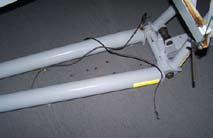
2 minute read
Nothing Is Routine
from MECH Fall 2008
By AD2 Anthony Foster
We arrived in Fallon for SFARP in October. The new eight-blade propeller on the Hawkeye is susceptible to erosion-related damage, and we found one damaged blade on our aircraft that was scheduled to fly the next day. After quickly unpacking, night check was tasked to replace the blade on Eagle 602. We were confident we could handle this typically routine job. However, we’d later learn we should have taken a few moments to discuss the pitch-dark night, the unfamiliar field, the lower-than-normal lighting, and the procedures for operating the equipment.
Advertisement
Night check had the new blade on Eagle 602 by 1900, and we were ready to put the crane away. For this job, we used an A/S32A-44 utility crane, and before checking it out, we inspected it in accordance with pre-op card 19-600-302-6-1. We backed the crane a few feet away from the nacelle and began lowering and folding it. A series of pins had to be removed in the proper sequence to prevent the support cables from bearing more weight than they are designed to hold. The main-mast pin had to be pulled last, after the load was removed. Without this pin, the mast cables would break under the strain of the boom. A warning placard on the crane described the procedure.
Despite our experience with the equipment and our knowledge of the warning, we failed to follow the correct procedures; we removed the main-mast pin first. This left the weight of the boom completely supported by the mast cables, which quickly parted. The boom crashed down onto the starboard propeller, gouging a blade and cracking the hub. Two safety cables and the main hoist cable on the crane also were destroyed.
In all, the mishap cost the squadron just under three thousand dollars. The aircraft could have been damaged
Damaged propeller from the boom crashing down on it.

much more severely had we not backed out the crane.
Cables were also destroyed.

Someone could have been killed too, had we not cleared the area under and around the crane.
We came out of this experience with some costly aircraft damage, and some valuable lessons learned. The damage to the aircraft could have been completely avoided had we backed the crane clear of the aircraft. If we had reviewed our procedures for stowing the crane before doing the maintenance, we would have been reminded of the warning about the main-mast pin. We also learned that nothing is routine when operating in dark and unfamiliar places. A few moments of ORM, thinking about what could go wrong in a different environment, might have saved us from this costly mistake.
Petty Officer Foster works in the power plants shop at VAW-113.










